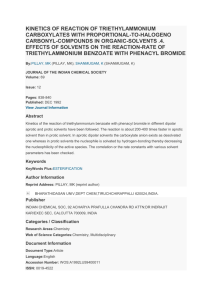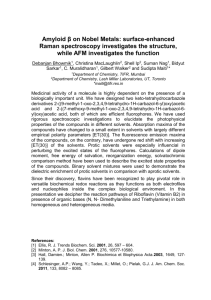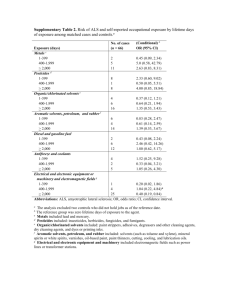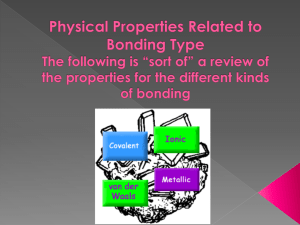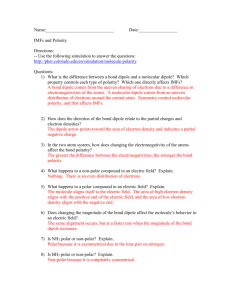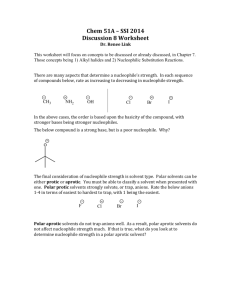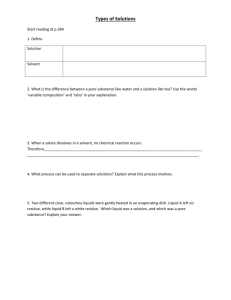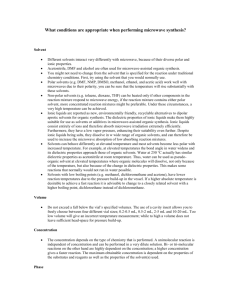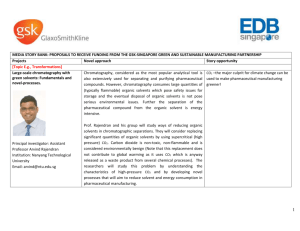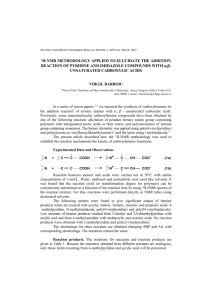Solvents Introduction The vast majority of chemical reactions are
advertisement
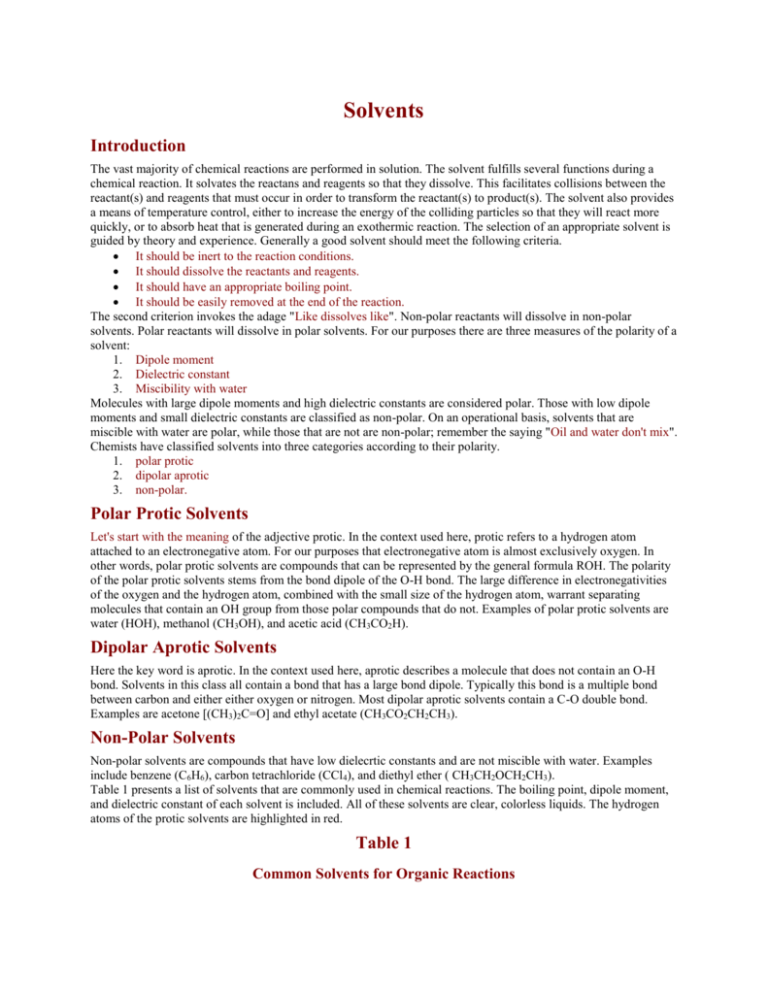
Solvents Introduction The vast majority of chemical reactions are performed in solution. The solvent fulfills several functions during a chemical reaction. It solvates the reactans and reagents so that they dissolve. This facilitates collisions between the reactant(s) and reagents that must occur in order to transform the reactant(s) to product(s). The solvent also provides a means of temperature control, either to increase the energy of the colliding particles so that they will react more quickly, or to absorb heat that is generated during an exothermic reaction. The selection of an appropriate solvent is guided by theory and experience. Generally a good solvent should meet the following criteria. It should be inert to the reaction conditions. It should dissolve the reactants and reagents. It should have an appropriate boiling point. It should be easily removed at the end of the reaction. The second criterion invokes the adage "Like dissolves like". Non-polar reactants will dissolve in non-polar solvents. Polar reactants will dissolve in polar solvents. For our purposes there are three measures of the polarity of a solvent: 1. Dipole moment 2. Dielectric constant 3. Miscibility with water Molecules with large dipole moments and high dielectric constants are considered polar. Those with low dipole moments and small dielectric constants are classified as non-polar. On an operational basis, solvents that are miscible with water are polar, while those that are not are non-polar; remember the saying "Oil and water don't mix". Chemists have classified solvents into three categories according to their polarity. 1. polar protic 2. dipolar aprotic 3. non-polar. Polar Protic Solvents Let's start with the meaning of the adjective protic. In the context used here, protic refers to a hydrogen atom attached to an electronegative atom. For our purposes that electronegative atom is almost exclusively oxygen. In other words, polar protic solvents are compounds that can be represented by the general formula ROH. The polarity of the polar protic solvents stems from the bond dipole of the O-H bond. The large difference in electronegativities of the oxygen and the hydrogen atom, combined with the small size of the hydrogen atom, warrant separating molecules that contain an OH group from those polar compounds that do not. Examples of polar protic solvents are water (HOH), methanol (CH3OH), and acetic acid (CH3CO2H). Dipolar Aprotic Solvents Here the key word is aprotic. In the context used here, aprotic describes a molecule that does not contain an O-H bond. Solvents in this class all contain a bond that has a large bond dipole. Typically this bond is a multiple bond between carbon and either either oxygen or nitrogen. Most dipolar aprotic solvents contain a C-O double bond. Examples are acetone [(CH3)2C=O] and ethyl acetate (CH3CO2CH2CH3). Non-Polar Solvents Non-polar solvents are compounds that have low dielecrtic constants and are not miscible with water. Examples include benzene (C6H6), carbon tetrachloride (CCl4), and diethyl ether ( CH3CH2OCH2CH3). Table 1 presents a list of solvents that are commonly used in chemical reactions. The boiling point, dipole moment, and dielectric constant of each solvent is included. All of these solvents are clear, colorless liquids. The hydrogen atoms of the protic solvents are highlighted in red. Table 1 Common Solvents for Organic Reactions Name Structure bp, oC dipole moment water methanol ethanol 1-propanol 1-butanol formic acid acetic acid formamide H-OH CH3-OH CH3CH2-OH CH3CH2CH2-OH CH3CH2CH2CH2-OH 100 68 78 97 118 100 118 210 1.85 1.70 1.69 1.68 1.66 1.41 1.74 3.73 dielectric constant 80 33 24.3 20.1 17.8 58 6.15 109 .... .... .... .... .... 56 80 78 81 153 189 2.88 2.78 1.78 3.92 3.82 3.96 20.7 18.5 6.02 36.6 38.3 47.2 acetone methyl ethyl ketone ethyl acetate acetonitrile N,N-dimethylformamide (DMF) diemthyl sulfoxide (DMSO) .... .... .... .... .... hexane benzene diethyl ether tetrahydrofuran (THF) methylene chloride carbon tetrachloride CH3(CH2)4 CH3 69 80 35 66 40 76 ---0 1.15 1.63 1.60 0 2.02 2.28 4.34 7.52 9.08 2.24 CH3CH2OCH2CH3 CH2Cl2 CCl4 It should be apparent from the table that there are no sharp boundaries between polar and non-polar solvents, at least if you use dielectric constants or dipole moments as a measure. There is, however, a correlation between chemical structure and dielectric constant that provides a useful way to think about polarity. Look at the series of polar protic compounds water, methanol, ethanol, 1-propanol, and 1-butanol. As Figure 1 demonstrates, each compound in the series differs from the ones before and after it by one CH2 group. Figure 1 Structure-Property Correlations As the number of CH2 groups in ROH increases, the dielectric constant decreases. If you think of these molecules as containing a polar component (OH) and a non-polar component (R), then the polarity of a compound reflects the balance between these two components. As the relative amount of hydrocarbon character increases, the polarity decreases. Note that hexane, which is 100% hydrocarbon, is the least polar solvent in the table.
